人教版(2019)选择性必修 第一册Unit 3 Fascinating Parks Listening part 课件 1 (18张ppt)
文档属性
| 名称 | 人教版(2019)选择性必修 第一册Unit 3 Fascinating Parks Listening part 课件 1 (18张ppt) | 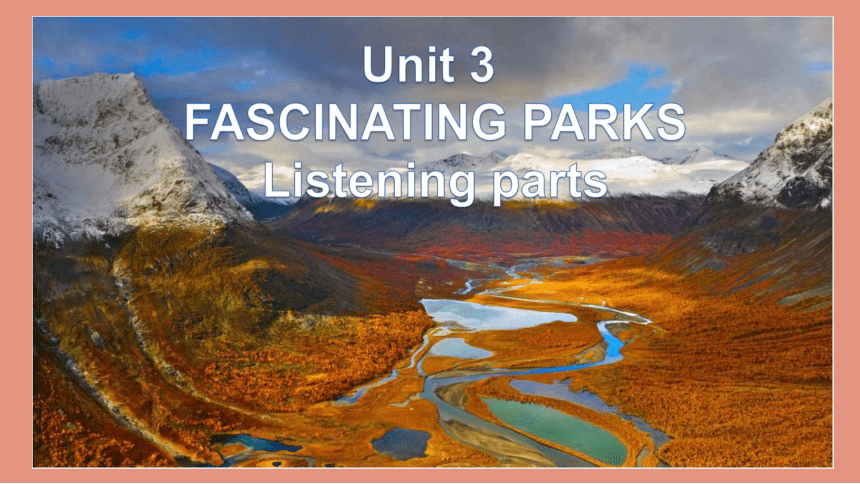 | |
| 格式 | zip | ||
| 文件大小 | 88.5MB | ||
| 资源类型 | 教案 | ||
| 版本资源 | 人教版(2019) | ||
| 科目 | 英语 | ||
| 更新时间 | 2021-10-20 17:48:18 | ||
图片预览

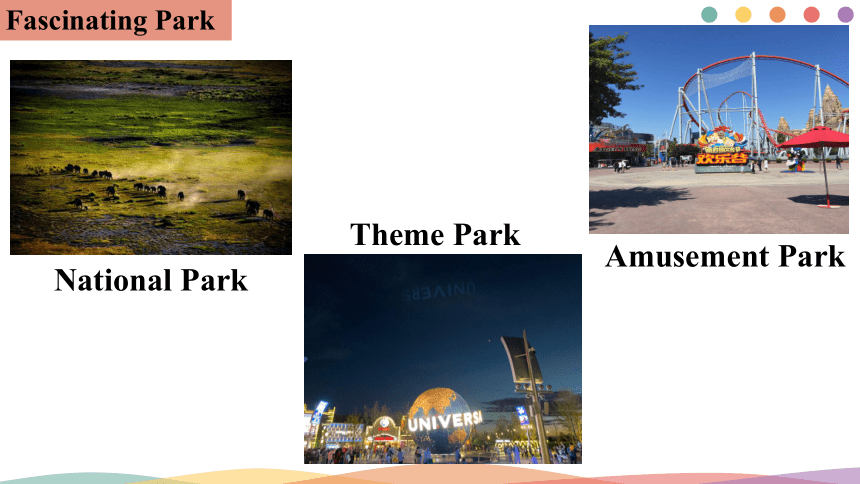
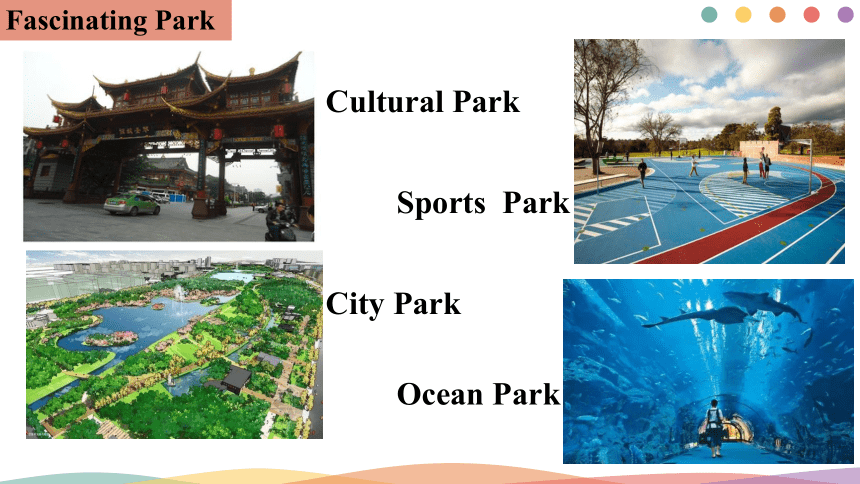

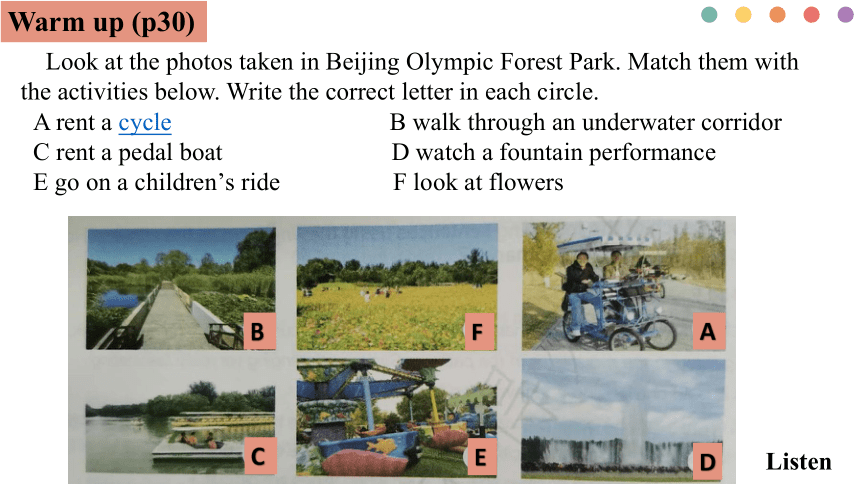
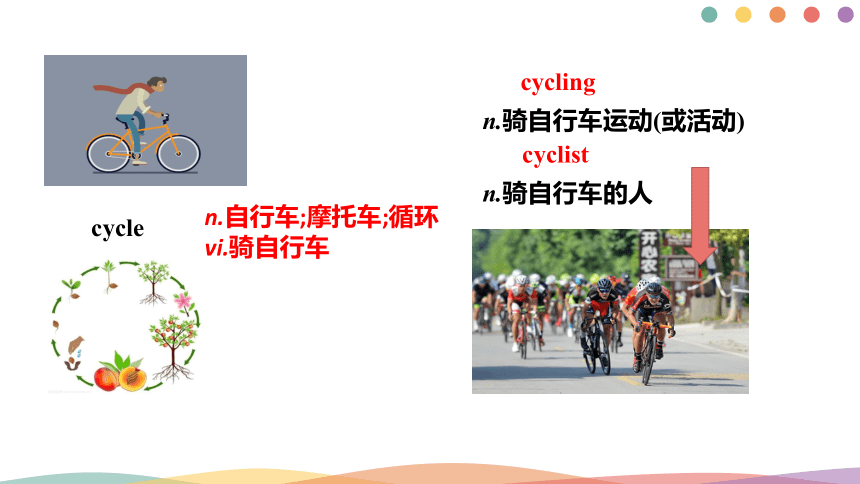
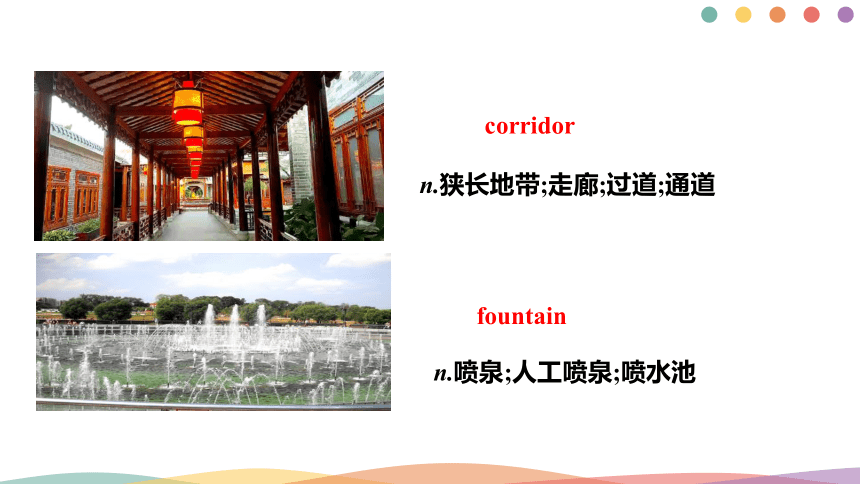
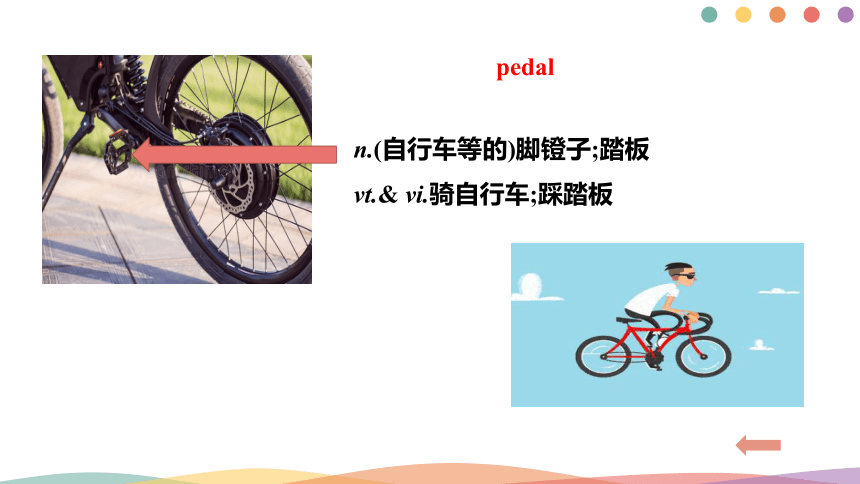

文档简介
(共24张PPT)
Unit 3
FASCINATING PARKS
Listening parts
Fascinating Park
National Park
Amusement Park
Theme Park
Fascinating Park
Cultural Park
City Park
Sports Park
Ocean Park
Warm up
Beijing Olympic Forest Park was built in 2008 to provide a place for athletes and coaches to relax during the Games. Located within easy walking distance north of the Bird’s Nest Stadium, it was given to the city after the games, and it is now the largest of Beijing’s city parks. The park is divided into two parts: the South Park and the North Park.
Warm up (p30)
Look at the photos taken in Beijing Olympic Forest Park. Match them with the activities below. Write the correct letter in each circle.
A rent a cycle B walk through an underwater corridor
C rent a pedal boat D watch a fountain performance
E go on a children’s ride F look at flowers
B
A
C
D
F
E
Listen
n.骑自行车运动(或活动)
n.骑自行车的人
cycle
n.自行车;摩托车;循环
vi.骑自行车
cycling
cyclist
corridor
n.狭长地带;走廊;过道;通道
fountain
n.喷泉;人工喷泉;喷水池
pedal
n.(自行车等的)脚镫子;踏板
vt.& vi.骑自行车;踩踏板
Listening
Linlin and Yuhui are taking Jake to Beijing Olympic Forest Park. Listen to their conversation. Tick which activities they are going to do.
Beijing Olympic Forest Park
Listening
Listen for directions
Listening for directions can be difficult, as often a lot of information is given in a short time. You could listen for sequence words(顺序词) and direction words,Such as turn left and follow…after that….You can also try to form a mental map of where you are going while the other person is talking. While listening, you should take some short notes.
Look at the map. Listen to the conversation and finish the activities below.
1. Writer down the directions you hear.
2. Draw the route that Jake, Linlin, and Yuhui will take.
3. Mark the places they will visit on the map.
Direction words
2nd
3nd
go up/down/straight/along/
north/south/east/west
turn left
turn right
go cross/across
turn around
turn left at the second turning
take the 3rd turning on your right
Intersection
十字路口
Direction words
The school is on your left.
The school is next to the hospital.
The school is opposite the hospital
The school is between the hospital and the supermarket
SCHOOL
go past the school
Go straight on, until you get to the school
SCHOOL
SCHOOL
The school is on your right.
SCHOOL
SCHOOL
HOSPITAL
SCHOOL
HOSPITAL
SCHOOL
HOSPITAL
SUPER MARKET
Listening
Look at the map. Listen to the conversation and finish the activities below.
1. Circle the places they will visit on the map.
2. Writer down the directions you hear.
3. Draw the route that Jake, Linlin, and Yuhui will take.
From here, we should go north
then turn left and follow the main road until we reach the second path on the right.
Then we turn right on the path
follow it for about three hundred metres until we come to an intersection with a washroom.
Then we should turn left on another path.
After about 150 metres, we’ll be at the underwater wetland corridor.
Listening materials
Yuhui: Now that we're at the park, where would you like to go first, Jake
Jake: I don't know. What interesting things can we see and do here
Yuhui: Well, Flower Land, fountain performances, children's rides...Oh! This is interesting--here's an underwater corridor!
Jake: That does sound interesting. How do we get there
Yuhui: Let me check the map on my phone...From here, we should go north, and then turn left and follow the main road until we reach the second path on the right. Then we turn right on the path and follow it for about three hundred metres until we come to an intersection with a washroom.Then we should turn left on another path. After about 150 metres, we'll be at the underwater wetland corridor.
Listening materials
Linlin: Oh, that sounds a bit far!
Jake: Well, maybe we can rent bikes to get there.
Yuhui: No, we can't. There are four-wheel cycles, but they are only allowed on certain fixed routes. Let me check the map again... Oh, we're actually very near the cycle rental place now. We could go there first, if you like.
Linlin: Yes, OK, it would be fun! Hopefully we can get close to the underwater wetland corridor, and I'd also like to take a pedal boat on Wali Lake afterwards.
Jake: Sounds like we've got a lot of things to do.
Yuhui: Yes, so we'd better get started.
Warming up (p77)
The Polynesian Cultural Center, located near Lay on the north shore of Oahu, Hawaii(夏威夷州瓦胡岛北岸莱伊附近), about 65 kilometers from Honolulu(檀香山), is a large national culture museum.Founded in 1963 by The Mormon Brigham Young University(摩门教杨百翰大学) to preserve Polynesian history and cultural traditions.
Listening
David Evans and Li Yang are visiting the Polynesian Cultural Centre in Hawaii. Listen to their conversation and answer the following questions.
1. How many different Polynesian cultures are represented at the park
2. What are canoes, and why are they important to the Polynesians
3. What did the Samoans use to make fire
4. Where do the Maori put the tattoos
5. Why does David tell Li Yang not to worry about getting a tattoo
Listening
1. How many different Polynesian cultures are represented at the park
2. What are canoes, and why are they important to the Polynesians
3. What did the Samoans use to make fire
4. Where do the Maori put the tattoos
5. Why does David tell Li Yang not to worry about getting a tattoo
Six.
Canoes are small boats that the Polynesians used to travel thousands of kilometres.
Using Sticks.
On their faces.
It’s not a real tattoo—it can be washed off.
Listening
Listen to the conversation again and finish the following tasks.
1. Locate the places they are going.
2. draw the route they will take.
Listening materials
David Evans: Here's a park map. Where should we start
Li Yang: I don’t get it. I thought this park was about Polynesian culture, but the park map shows six different cultures
David Evans: Well, though the people of Polynesia are all related, Polynesia is made up of several different cultures spread out across the South Pacific.
Li Yang: Oh. I see. So what can we do here
David Evans: For a start, we can take a canoe tour of the park.
Li Yang: Canoe What's that
David Evans: It's a small boat. Traditional canoes are carved from a single tree, so they are often quite narrow. The Polynesians used canoes to travel thousands of kilometers.
Li Yang: That’s interesting. Where do we go to find them
David Evans: Well, to get to the canoes, we need to go straight. Then after we cross the bridge, we turn left. They should be quite near there … Then after the canoes, we can learn how to make fire the traditional way, using sticks
Li Yang: Where can we do that
David Evans: The guide says we should go to the Samoan Village. That shouldn't be very hard to find. From the canoes, we just go straight, and then take the bridge on the right. It should be a short walk away on the left. Oh, and next to the Samoan Village is the Aotearoan Village. We can get Maori tattoos 刺青,纹身 there.
Li Yang: Maori tattoos
David Evans: Yes. The Maori like to tattoo their faces with interesting designs.
Li Yang: But I don't want to tattoo my face.
David Evans: Don’t worry! It's not a real tattoo. We can wash it off later.
Li Yang: Cool! But first, the canoe tour.
David Evans: Yes! I can’t wait. Let's go.
Expressions
ahead adv.向前; 在前面; 提前
→ (拓展) ahead of… 在...前面
ahead of time 提前
ahead of schedule 提前
Make a conversation
Choose one place on the map of Beijing Olympic Forest Park on P30.
Make a conversation of asking for and giving directions to these places in the park with your classmates.
Use the words and phrases given to help you.
Unit 3
FASCINATING PARKS
Listening parts
Fascinating Park
National Park
Amusement Park
Theme Park
Fascinating Park
Cultural Park
City Park
Sports Park
Ocean Park
Warm up
Beijing Olympic Forest Park was built in 2008 to provide a place for athletes and coaches to relax during the Games. Located within easy walking distance north of the Bird’s Nest Stadium, it was given to the city after the games, and it is now the largest of Beijing’s city parks. The park is divided into two parts: the South Park and the North Park.
Warm up (p30)
Look at the photos taken in Beijing Olympic Forest Park. Match them with the activities below. Write the correct letter in each circle.
A rent a cycle B walk through an underwater corridor
C rent a pedal boat D watch a fountain performance
E go on a children’s ride F look at flowers
B
A
C
D
F
E
Listen
n.骑自行车运动(或活动)
n.骑自行车的人
cycle
n.自行车;摩托车;循环
vi.骑自行车
cycling
cyclist
corridor
n.狭长地带;走廊;过道;通道
fountain
n.喷泉;人工喷泉;喷水池
pedal
n.(自行车等的)脚镫子;踏板
vt.& vi.骑自行车;踩踏板
Listening
Linlin and Yuhui are taking Jake to Beijing Olympic Forest Park. Listen to their conversation. Tick which activities they are going to do.
Beijing Olympic Forest Park
Listening
Listen for directions
Listening for directions can be difficult, as often a lot of information is given in a short time. You could listen for sequence words(顺序词) and direction words,Such as turn left and follow…after that….You can also try to form a mental map of where you are going while the other person is talking. While listening, you should take some short notes.
Look at the map. Listen to the conversation and finish the activities below.
1. Writer down the directions you hear.
2. Draw the route that Jake, Linlin, and Yuhui will take.
3. Mark the places they will visit on the map.
Direction words
2nd
3nd
go up/down/straight/along/
north/south/east/west
turn left
turn right
go cross/across
turn around
turn left at the second turning
take the 3rd turning on your right
Intersection
十字路口
Direction words
The school is on your left.
The school is next to the hospital.
The school is opposite the hospital
The school is between the hospital and the supermarket
SCHOOL
go past the school
Go straight on, until you get to the school
SCHOOL
SCHOOL
The school is on your right.
SCHOOL
SCHOOL
HOSPITAL
SCHOOL
HOSPITAL
SCHOOL
HOSPITAL
SUPER MARKET
Listening
Look at the map. Listen to the conversation and finish the activities below.
1. Circle the places they will visit on the map.
2. Writer down the directions you hear.
3. Draw the route that Jake, Linlin, and Yuhui will take.
From here, we should go north
then turn left and follow the main road until we reach the second path on the right.
Then we turn right on the path
follow it for about three hundred metres until we come to an intersection with a washroom.
Then we should turn left on another path.
After about 150 metres, we’ll be at the underwater wetland corridor.
Listening materials
Yuhui: Now that we're at the park, where would you like to go first, Jake
Jake: I don't know. What interesting things can we see and do here
Yuhui: Well, Flower Land, fountain performances, children's rides...Oh! This is interesting--here's an underwater corridor!
Jake: That does sound interesting. How do we get there
Yuhui: Let me check the map on my phone...From here, we should go north, and then turn left and follow the main road until we reach the second path on the right. Then we turn right on the path and follow it for about three hundred metres until we come to an intersection with a washroom.Then we should turn left on another path. After about 150 metres, we'll be at the underwater wetland corridor.
Listening materials
Linlin: Oh, that sounds a bit far!
Jake: Well, maybe we can rent bikes to get there.
Yuhui: No, we can't. There are four-wheel cycles, but they are only allowed on certain fixed routes. Let me check the map again... Oh, we're actually very near the cycle rental place now. We could go there first, if you like.
Linlin: Yes, OK, it would be fun! Hopefully we can get close to the underwater wetland corridor, and I'd also like to take a pedal boat on Wali Lake afterwards.
Jake: Sounds like we've got a lot of things to do.
Yuhui: Yes, so we'd better get started.
Warming up (p77)
The Polynesian Cultural Center, located near Lay on the north shore of Oahu, Hawaii(夏威夷州瓦胡岛北岸莱伊附近), about 65 kilometers from Honolulu(檀香山), is a large national culture museum.Founded in 1963 by The Mormon Brigham Young University(摩门教杨百翰大学) to preserve Polynesian history and cultural traditions.
Listening
David Evans and Li Yang are visiting the Polynesian Cultural Centre in Hawaii. Listen to their conversation and answer the following questions.
1. How many different Polynesian cultures are represented at the park
2. What are canoes, and why are they important to the Polynesians
3. What did the Samoans use to make fire
4. Where do the Maori put the tattoos
5. Why does David tell Li Yang not to worry about getting a tattoo
Listening
1. How many different Polynesian cultures are represented at the park
2. What are canoes, and why are they important to the Polynesians
3. What did the Samoans use to make fire
4. Where do the Maori put the tattoos
5. Why does David tell Li Yang not to worry about getting a tattoo
Six.
Canoes are small boats that the Polynesians used to travel thousands of kilometres.
Using Sticks.
On their faces.
It’s not a real tattoo—it can be washed off.
Listening
Listen to the conversation again and finish the following tasks.
1. Locate the places they are going.
2. draw the route they will take.
Listening materials
David Evans: Here's a park map. Where should we start
Li Yang: I don’t get it. I thought this park was about Polynesian culture, but the park map shows six different cultures
David Evans: Well, though the people of Polynesia are all related, Polynesia is made up of several different cultures spread out across the South Pacific.
Li Yang: Oh. I see. So what can we do here
David Evans: For a start, we can take a canoe tour of the park.
Li Yang: Canoe What's that
David Evans: It's a small boat. Traditional canoes are carved from a single tree, so they are often quite narrow. The Polynesians used canoes to travel thousands of kilometers.
Li Yang: That’s interesting. Where do we go to find them
David Evans: Well, to get to the canoes, we need to go straight. Then after we cross the bridge, we turn left. They should be quite near there … Then after the canoes, we can learn how to make fire the traditional way, using sticks
Li Yang: Where can we do that
David Evans: The guide says we should go to the Samoan Village. That shouldn't be very hard to find. From the canoes, we just go straight, and then take the bridge on the right. It should be a short walk away on the left. Oh, and next to the Samoan Village is the Aotearoan Village. We can get Maori tattoos 刺青,纹身 there.
Li Yang: Maori tattoos
David Evans: Yes. The Maori like to tattoo their faces with interesting designs.
Li Yang: But I don't want to tattoo my face.
David Evans: Don’t worry! It's not a real tattoo. We can wash it off later.
Li Yang: Cool! But first, the canoe tour.
David Evans: Yes! I can’t wait. Let's go.
Expressions
ahead adv.向前; 在前面; 提前
→ (拓展) ahead of… 在...前面
ahead of time 提前
ahead of schedule 提前
Make a conversation
Choose one place on the map of Beijing Olympic Forest Park on P30.
Make a conversation of asking for and giving directions to these places in the park with your classmates.
Use the words and phrases given to help you.
